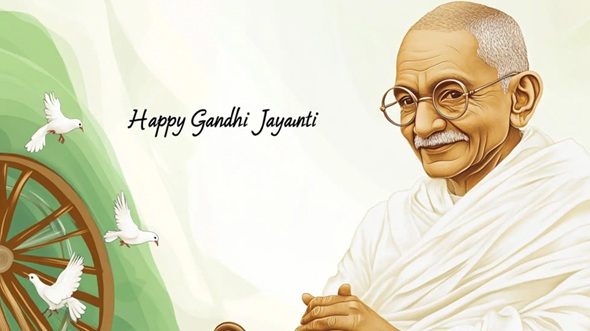
- Gandhi Jayanti is not just a celebration of Mahatma Gandhi’s birthday.
- It commemorates the remarkable journey of truth, non-violence, and moral courage that led India to independence. His experiences in South Africa taught him the importance of non-violent resistance, which later inspired millions during India’s freedom struggle.
Mahatma Gandhi: Father of the Nation and Pioneer of Satyagraha
Mahatma Gandhi was not only a leader of India’s independence movement but also a guide in the path of truth and non-violence. His life demonstrates that simplicity, determination, and moral strength can lay the foundation for profound socio-political change.
Early Life
- Birth: 2 October 1869, Porbandar, Gujarat.
- Parents: Karamchand Gandhi and Putlibai.
- In childhood, teachings from Vaishnavism and Jainism instilled in him values of truth, non-violence, tolerance, and renunciation.
- Stories of Shravan and Harishchandra laid the foundation of his honesty and moral firmness.
First Struggle in South Africa: Fighting Against Injustice
- Facing Racial Discrimination: In 1893, Gandhi went to South Africa, where he faced severe racial discrimination.
- Famous Incident: Despite holding a valid ticket, he was thrown out of a first-class railway compartment.
- This humiliation ignited within him the flame of Satyagraha and non-violence.
Struggle and Contributions
- 1894: Began non-violent resistance against racial discrimination.
- 1899: Formed the Indian Ambulance Corps during the Boer War.
- Established Phoenix and Tolstoy Farms — training centers for Satyagraha.
- 1906: Led the first Satyagraha movement in Transvaal.
- Conducted several marches, faced repeated imprisonment, and attracted global attention.
- South Africa became a laboratory for Gandhi’s experiments with Satyagraha and non-violence.
Return to India and Entry into Politics
In 1915, Gandhi returned to India and traveled extensively to understand social and political issues.
- Deep connection with the poor, farmers, and laborers.
- Gained widespread respect and trust among the people.
Major Movements in India
Champaran Satyagraha (1917)
- The first successful movement against the exploitation of farmers in Bihar.
- Protection of farmers’ rights in indigo plantations.
Kheda Satyagraha (1918)
- Struggle against economic hardships of farmers in Gujarat.
- Focused on tax relief and crop issues.
Khilafat and Non-Cooperation Movement (1920-22)
- Efforts to unite Hindus and Muslims.
- Boycott of British goods, schools, and titles.
- Movement suspended after the Chauri-Chaura violence.
Presidency of Congress:
- Gandhi presided over the Belgaum session of the Indian National Congress (1924).
- Notably, this was the only Congress session presided over by Gandhi himself.
Civil Disobedience Movement (1930)
- Historic Dandi March and violation of the salt laws.
- Nationwide wave of peaceful protest.
Round Table Conference and Gandhi-Irwin Pact (1931)
- Participated in the Second Round Table Conference in London.
- The pact brought temporary political relief and release of prisoners.
Quit India Movement (1942)
- Call for “Do or Die.”
- Arrest of leaders and nationwide protests.
Assassination and Immortal Legacy
- 30 January 1948: Assassinated by Nathuram Godse.
- His death was an irreparable loss to the nation and the world.
- His teachings continue to inspire leaders worldwide, including Martin Luther King Jr. and Nelson Mandela.
- Samadhi: Raj Ghat, New Delhi.
|
Question: Which edition of Mahatma Gandhi Jayanti will be celebrated in 2025 ?
(a) 156th
(b) 155th
(c) 154th
(d) 150th
|



